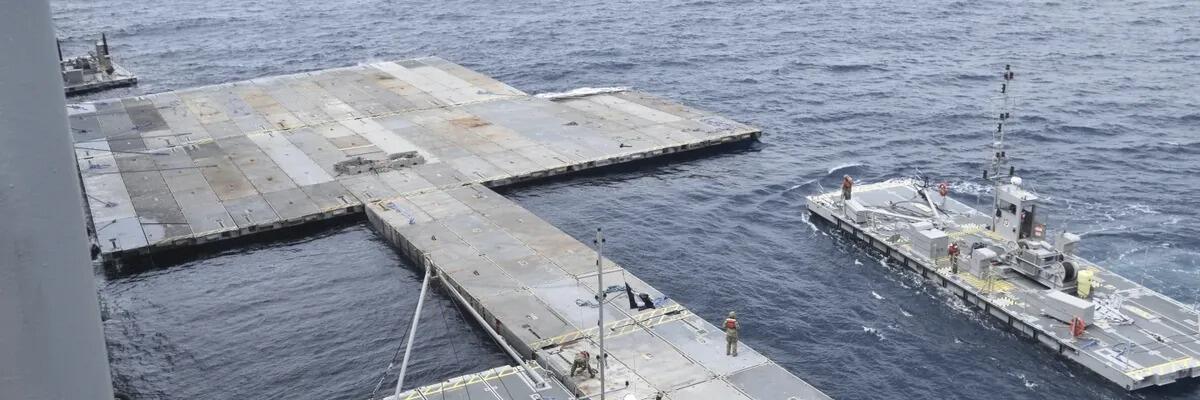Authored by Ann Wright via CommonDreams.org,
Instead of U.S. President Joe Biden marking a red line in the sand demanding that Israel allow aid into Gaza via ground transportation, his inept diplomatic team sent out a plea for help to the U.S. military.
While in the U.S. Army and Army Reserves for 29 years, I thought I had seen some pretty stupid things the military was told by politicians to do. It always begins with politicians deciding the easiest, most sensible solution to a problem would have too much political baggage and cost them votes in the next election. So, they look for a politically expedient solution, one that is invariably very expensive and convoluted.
Attempting a Military Solution for a Political or Diplomat Problem—AGAIN!!!
In this vein, all too often, politicians turn to the U.S. military for a solution to a non-military problem. Then some A-type personality in the military presents a hair-brained idea to the politicians, probably never thinking that the idea would be accepted. Then it is accepted to get the politicians out of a jam, and the next thing you know is that the Rube Goldberg, crazy idea is being funded.
This unbelievable scenario is what has happened with getting humanitarian aid into Gaza for the starving survivors of the Israeli genocide of Gaza. Instead of U.S. President Joe Biden marking a red line in the Israel/Gaza/Egypt sand demanding that Israel allow into Gaza the miles of tractor-trailer loads of food and medicine that have been stalled for months at the Rafah border crossing, Biden's inept diplomatic team sent out a plea for help to the U.S. military.
Palestinians in Gaza and citizens around the world will not forget that miles of supplies are just feet away from Gaza at the Rafah crossing and the U.S. will not use its pressure on Israel to open the gates at Rafah.
And the U.S. military, always looking for validation of its immense "capabilities," seized the opportunity to use one of its little-known assets—the Army's Joint Logistics Over the Shore, or JLOTS, system that provides bridging and water access capabilities—to help out the failed U.S. diplomatic efforts to get the U.S.'s "strongest ally in the Middle East" to end the starvation of hundreds of thousands of Palestinians in Gaza by letting the massive truck convoys filled with food and medicines into Gaza.
Normally used to move military equipment across rivers where bridges have been blown up—many times by the U.S. military itself—and sometimes to transfer military equipment from a ship onto shore, the U.S. Army's small navy swung into action and began sailing to the Mediterranean in U.S. Army ships filled with barges that can be locked together to form landing docks and causeways.
Rube Goldberg Complex of Construction and Transportation Ideas
In a Rube Goldberg complex of construction and transportation ideas, the U.S. military anchored to the sea floor three miles off the northern coast of Gaza a floating dock system onto which large cargo ships can dock.
Cargo ships will off-load pallets and possibly container loads of humanitarian assistance—long-life packaged food and medical supplies—on the three-mile off-shore dock. This cargo will have undergone inspection by Israeli authorities in the port of Larnaca, Cyprus, 200 miles from Gaza.
The inspection process involves Cypriot customs, Israeli teams, the U.S., and the United Nations Office for Project Services. The U.S. Agency for International Development has set up a coordination cell in Cyprus.
Two-thousand trucks to offload ONE ship driving 1,800 feet on a causeway that will be dangerously affected by tides, winds, and waves is a recipe for disaster.
From the cargo ships, food and medical supplies will be transferred into the backs of U.S. Army trucks (probably 2.5-ton trucks) that have arrived on the floating pier brought there by two types of smaller Army boats—Logistic Support Vessels, or LSVs, and Landing Craft Utility boats (LCUs). LSVs can hold 15 trucks each and the LCUs about five.
The loaded 2.5-ton trucks will be driven back onto the LSVs and motored three miles to the second floating pier system constructed by the U.S. military.
The trucks will then be driven off the LSVs onto the second pier and down a two-lane, 1,800-foot (six U.S. football fields long) causeway anchored onto Gaza land by the Israeli military. The causeway will be anchored onto Gaza shores by the Israeli military because the U.S. military is forbidden to have "boots on the ground" in Gaza.
The truckloads of food and medical supplies will then be driven somewhere... and supplies distributed by some organization... yet to be determined according to the latest news reports.
The empty trucks will then be driven back along the two-lane, 1,800-foot causeway to the floating pier where they will be driven into the small LSVs, and the LSVs then sailed back three miles to the larger off-shore pier and the process begun again. The long causeway should be a cause of alarm for drivers, as the winds and waves so dramatically affected the construction of the causeway that most of the causeway was put together in the calm waters of Ashdod, an Israeli harbor, after winds and waves made construction of the causeway in place off Gaza impossible. Parts of the causeway are now being towed 20 miles from Ashdod harbor to northern Gaza to be linked into place.
While Thousands of Truck Loads of Cargo Wait at the Rafah Border Crossing, It Will Take 2,000 Truck Loads to Empty Each 5,000 Ton Cargo Ship
if a large cargo ship has 5,000 tons of food and medical supplies to be off-loaded, and if each truck can hold 2.5 tons of cargo, it will take 2,000 trucks to take the cargo from one ship. If there are 15 trucks on each LSV, then the LSVs will have to make 133 trips to get the trucks to the 1,800 foot causeway.
If the LCUs that hold only five trucks are mostly used, then it would take 400 trips to get the cargo to shore.
Two-thousand trucks to offload ONE ship driving 1,800 feet on a causeway that will be dangerously affected by tides, winds, and waves is a recipe for disaster.
A graphic, not to scale, showing how the aid delivery system will work. (Photo: Department of Defense)
Will Israel Bomb the Docks, Piers, and Causeway? Remember the USS Liberty!
The possibility of probability is high that Israeli military jets, drones, and artillery may "mistakenly" target the pier complex... or Hamas or other militant groups may decide that the U.S. complicity in the genocide of over 35,000 Palestinians in Gaza outweighs the meager food and medical supplies the U.S. is bringing into Gaza, which presents another aspect of the recipe for disaster for the U.S. Rube Goldberg pier.
U.S. military personnel should remember the Israeli attack on a U.S. military ship, the USS Liberty. In 1967, the Israeli military bombed and torpedoed a U.S. ship off Gaza, killing 34 and wounding 171, and almost sunk the ship. The U.S. cover-up for its ally Israel's brutal, lethal attack on a U.S. military ship continues to this day, as does the U.S. complicity in the Israeli genocide of Gaza.
The World Will Not Forget
Palestinians in Gaza and citizens around the world will not forget that miles of supplies are just feet away from Gaza at the Rafah crossing and the U.S. will not use its pressure on Israel to open the gates at Rafah, instead offering an expensive, idiotic solution to an easily solvable problem.



No comments:
Post a Comment